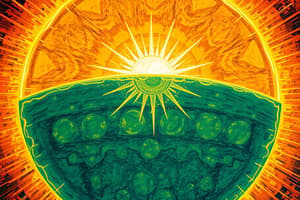Podcast
Questions and Answers
What is the name of the visible surface of the sun?
What is the name of the visible surface of the sun?
Photosphere
What is the name of the outermost part of the Sun's atmosphere?
What is the name of the outermost part of the Sun's atmosphere?
Corona
Sunspots are hotter than their surroundings.
Sunspots are hotter than their surroundings.
False (B)
Solar flares are a quick explosion of electromagnetic energy from the sun.
Solar flares are a quick explosion of electromagnetic energy from the sun.
What are prominences?
What are prominences?
What are solar neutrinos?
What are solar neutrinos?
What causes solar flares?
What causes solar flares?
What is the solar wind?
What is the solar wind?
What are the three layers of the sun's interior?
What are the three layers of the sun's interior?
What is the name of the study of the sun's interior?
What is the name of the study of the sun's interior?
The chromosphere is the sun's visible surface.
The chromosphere is the sun's visible surface.
Flashcards
Solar Neutrinos
Solar Neutrinos
Subatomic particles from the Sun's core nuclear fusion.
Photosphere
Photosphere
The Sun's visible surface, emitting light.
Sunspots
Sunspots
Dark areas on the Sun's surface due to magnetic activity.
Solar Prominences
Solar Prominences
Signup and view all the flashcards
Solar Flares
Solar Flares
Signup and view all the flashcards
Chromosphere
Chromosphere
Signup and view all the flashcards
Corona
Corona
Signup and view all the flashcards
Solar Wind
Solar Wind
Signup and view all the flashcards
Nuclear Fusion
Nuclear Fusion
Signup and view all the flashcards
Temperature (Sunspots)
Temperature (Sunspots)
Signup and view all the flashcards
Temperature (Chromosphere)
Temperature (Chromosphere)
Signup and view all the flashcards
Temperature (Corona)
Temperature (Corona)
Signup and view all the flashcards
Helioseismology
Helioseismology
Signup and view all the flashcards
Granules
Granules
Signup and view all the flashcards
Faculae
Faculae
Signup and view all the flashcards
Solar cycle
Solar cycle
Signup and view all the flashcards
Solar System Role
Solar System Role
Signup and view all the flashcards
Plasma
Plasma
Signup and view all the flashcards
Energy Transport
Energy Transport
Signup and view all the flashcards
Study Notes
- Learning outcomes include the Sun's structure (core, radiative zone, convective zone, photosphere, chromosphere, and corona), nuclear fusion processes in the core, and energy transport through layers.
- Further learning outcomes involve analyzing the significance of solar neutrinos in confirming theories about the Sun's energy production, challenges in detecting solar neutrinos, and their contributions to solar physics.
- Additional outcomes include understanding the Sun's structure and processes affecting space weather and Earth's environment, and creating an infographic about the Sun's life cycle.
- Specific topics include the general structure of the Sun, solar neutrinos, sunspots, prominences and flares, the chromosphere, the corona, helioseismology, and the solar wind.
- Solar neutrinos are subatomic particles formed during nuclear fusion in the Sun's core.
- The photosphere is the visible surface of the Sun, emitting light.
- Sunspots are temporary dark areas on the Sun's surface, caused by magnetic activity.
- Sunspots are cooler than their surroundings.
- The number of sunspots fluctuates over an 11-year cycle.
- Solar prominences are bright arches rising from the outer layers of the Sun's atmosphere due to ionized gas trapped by magnetic arches.
- Solar prominences can last from minutes to months.
- Solar flares are quick explosions of electromagnetic energy from the Sun, affecting hotness and acceleration of particles.
- Flares occur when intense magnetic fields become tangled.
- Solar flares disrupt technology, affect satellites and spacecraft, and endanger astronauts.
- The largest recorded solar flare occurred on April 2, 2001, observed by SOHO.
- The chromosphere sits above the photosphere, with a lower density than Earth's atmosphere, and a temperature near 3,700–8,000 K.
- Plasma storms and solar phenomena originate in the chromosphere.
- The Corona is the outermost part of the Sun's atmosphere, made of plasma, extending thousands of kilometres above the visible surface.
- The corona is hundreds of times hotter than the Sun's surface, reaching millions of degrees.
- The corona is visible during a total solar eclipse.
- The Parker Solar Probe, in December 2021, became the first spacecraft to encounter and sample the corona.
- The solar wind is a stream of charged particles from the corona, travelling at over one million miles per hour.
- As the solar wind travels further from the Sun, it becomes thinner.
- Above sunspot active regions magnetic disturbances cause loops of magnetic field lines to trap some plasma.
Studying That Suits You
Use AI to generate personalized quizzes and flashcards to suit your learning preferences.




